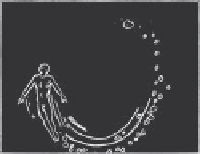Graphics Reference
In-Depth Information
not interested in reproducing a living room on stage. Some of the audience was disappointed
not to see a beautifully detailed gothic interior for our
The Turn of the Screw.
This is hardly a literal
piece, with most of the cast unbalanced one way or the other. What the audience saw was a
huge dolls' house doubling as a bed, a table, a garden, a tower, well everything. It seemed to
embody perfectly a fractured childhood. Around this dolls' house lay broken toys, unused toys,
unread topics, empty birdcages, all covered in dead leaves. Vast cloudy gauzes l uttered to the
ground, progressively making the stage even more insubstantial, and allowing the i gures of
the ghosts to be half glimpsed. Everything became less and less solid, echoing the state of Miss
Grey's mind. Not a realistic approach, but that's not my strength. This lies in coming up with
concepts, conventions and visual metaphors that provide a gloriously theatrical space for the
actors to play in. I try not to upstage the actors with the design, instead making them stand out,
using the design to set the mood and atmosphere, and to make a statement. My heart sinks
when a curtain goes up revealing a very literal representation, with no design idea or a point of
view, much as my heart sinks with rotoscoping in animation. It's seems a waste of the potential
of such artii ce as theatre and animation. There's always room for some interesting stylisation.
In anything I do, I like to read through the script a couple of times, and note down my gut
reaction, or what themes leapt of the page, and usually try to keep hold of these. As with my
animation, it's important for me to i nd the central image that will best serve the play before
I even think of any staging ideas.
Colours often appear i rst. If the piece strikes me as somewhat farcical, I will probably start to
rule out sombre colours. I would probably have a hard time directing a farce in a black box, or
Macbeth
in bright primary colours. As colours and brightness seem appropriate for comedy,
so darker colours and shadows seem appropriate for tragedy. Many a topic has been written
about the emotional qualities of colour, and it's essential that I use them as another dramatic
element. Most things I do have a journey plotted by colour and design. The tone and the
rhythm of the piece also need to be found straight away.
Habeas Corpus
I need discipline and parameters in any form of creative activity. At the Garrick, this discipline
is time, facilities and the sheer feat of getting it all done, while coping with day jobs and real
lives.
Next
worked as I had only one main puppet. Alan Bennett asks for an empty stage for his
Habeas Corpus
, but our audiences appreciate something to look at and an empty stage might
be too challenging. With our crew busy on bigger productions, necessitating simplicity, I kept
reading the script, trying to i nd a clue to a striking but economic image. The dialogue was full
of innuendo and risqué puns, and couples swapped partners with earthy, dance-like energy.
The play is a farce with some scenes a mere two lines in total, giving a clue to the pacing
required. I wanted to include dance, especially the tango mentioned in the script, but that is a
hard dance to perfect in so short a time and it seemed too overtly sexual for the
more naughty comic sexuality of the play. Farce is essentially about the promise
or threat of sex, rather than sex itself. Suddenly the maypole popped up, and that
satisi ed everything. It's clearly a sexual innuendo in itself, and involves simple,
ef ective dancing. It is also colourful and comical. The maypole generates a circular
shape, and leads to men and women swapping partners quite naturally, and the
knotting ribbons are a i tting visualisation of the plot.


Search WWH ::

Custom Search